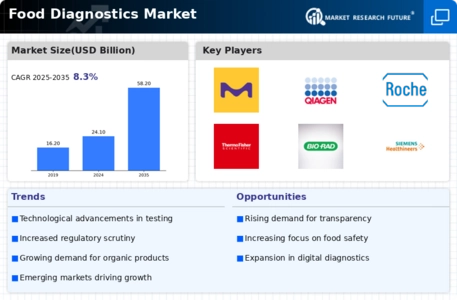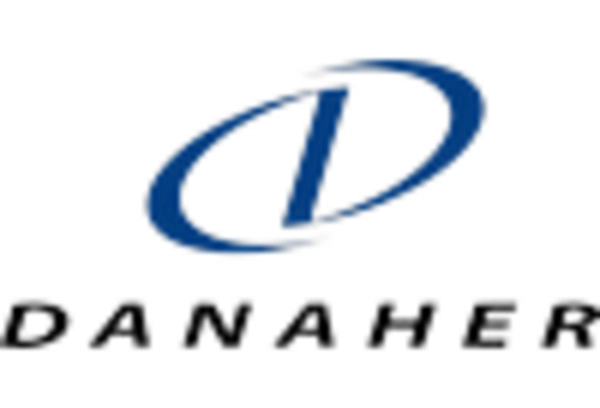Growing Consumer Awareness
The increasing awareness among consumers regarding food safety and quality is a pivotal driver for the Food Diagnostics Market. As consumers become more informed about the potential health risks associated with contaminated food, they demand higher standards of food safety. This trend is reflected in the rising sales of food testing kits and services, which are projected to reach USD 20 billion by 2026. The heightened scrutiny on food products has compelled manufacturers to adopt stringent testing protocols, thereby propelling the growth of the Food Diagnostics Market. Furthermore, regulatory bodies are also emphasizing the need for comprehensive food safety measures, which further supports the demand for diagnostic solutions. This consumer-driven shift towards transparency and safety is likely to continue influencing the market dynamics in the foreseeable future.
Expansion of Food Supply Chains
The globalization of food supply chains is a driving force behind the Food Diagnostics Market. As food products are sourced from various regions, the complexity of ensuring food safety increases. This globalization necessitates rigorous testing to prevent contamination and ensure compliance with safety standards. The market for food diagnostics is projected to grow as companies invest in testing solutions to monitor their supply chains effectively. The increasing number of food recalls, which reached over 1,000 incidents in the past year, highlights the critical need for robust diagnostic measures. Furthermore, as consumers demand transparency regarding the origins of their food, businesses are compelled to implement comprehensive testing protocols. This trend is likely to propel the Food Diagnostics Market forward, as companies seek to enhance their supply chain integrity and consumer trust.
Regulatory Compliance and Standards
The stringent regulatory environment surrounding food safety is a significant driver for the Food Diagnostics Market. Governments and international organizations have established rigorous standards to ensure food safety, which necessitates the implementation of effective diagnostic solutions. For instance, the Food Safety Modernization Act in the United States mandates that food manufacturers adopt preventive controls and conduct regular testing. This regulatory framework has led to an increased demand for food testing services and technologies, as companies strive to comply with these regulations. The market for food diagnostics is expected to grow at a compound annual growth rate of 7.5% through 2027, driven by the need for compliance with evolving food safety standards. As regulations become more stringent, the Food Diagnostics Market is likely to experience sustained growth as businesses invest in advanced testing solutions.
Rising Incidence of Foodborne Illnesses
The alarming rise in foodborne illnesses is a critical driver for the Food Diagnostics Market. According to the World Health Organization, foodborne diseases affect millions of people each year, leading to significant health and economic burdens. This increasing incidence has heightened the focus on food safety and quality, prompting both consumers and businesses to prioritize food testing. The market for food diagnostics is expected to expand as stakeholders seek to mitigate risks associated with foodborne pathogens. The economic impact of foodborne illnesses, estimated at USD 15 billion annually in healthcare costs, underscores the necessity for effective diagnostic solutions. Consequently, the Food Diagnostics Market is likely to witness robust growth as the demand for reliable testing methods escalates in response to these public health challenges.
Technological Advancements in Testing Methods
The rapid advancements in testing technologies are transforming the Food Diagnostics Market. Innovations such as PCR (Polymerase Chain Reaction) and next-generation sequencing are enhancing the accuracy and speed of food testing. These technologies allow for the detection of pathogens and contaminants at unprecedented levels of sensitivity, which is crucial for ensuring food safety. The market for molecular diagnostics in food testing is projected to grow significantly, with estimates suggesting a value of USD 5 billion by 2025. Additionally, the integration of artificial intelligence and machine learning in food diagnostics is streamlining testing processes and improving data analysis. As these technologies continue to evolve, they are likely to play a crucial role in shaping the future of the Food Diagnostics Market, making testing more efficient and reliable.


















Leave a Comment